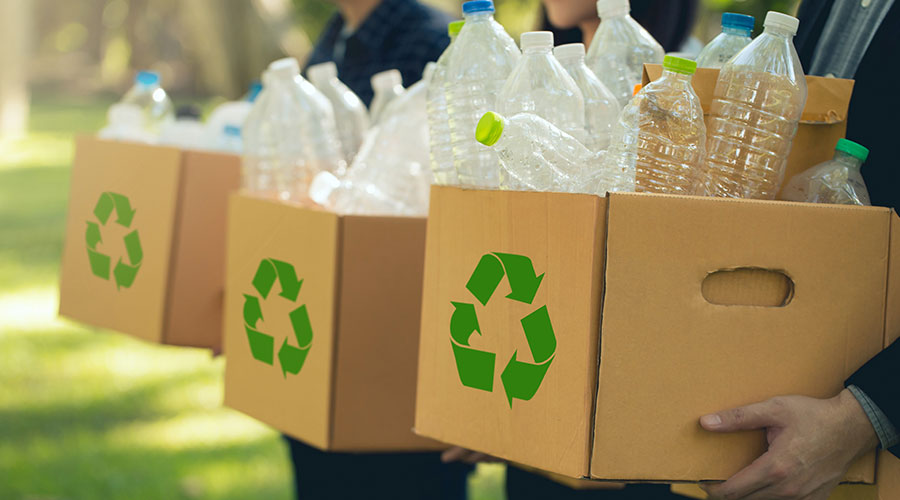How LEED v4.1 Addresses Embodied Carbon
Several Materials & Resources credits within LEED v4.1 seek to reduce the embodied carbon and thus the environmental impact of building products.
By Emma Hughes, LEED project manager, U.S. Green Building Council
The U.S. Green Building Council’s vision for materials and resources in the built environment comprises three strategies: reduce embodied carbon; protect human and ecological health; and advance the circular economy. Each of these strategies requires continuous optimization and robust data to make informed decisions. Reducing embodied carbon is a key consideration for buildings and spaces, and by focusing on building structural systems, enclosures, products and materials, project teams can make a significant and positive impact.
The LEED rating system takes a holistic approach to evaluating building products and materials. The Materials and Resources (MR) credit category in LEED v4.1, the latest update to the rating system, is an important place to start. The requirements reward building reuse; life-cycle analysis in the form of whole-building life cycle assessment and environmental product declarations (EPDs); material ingredient reporting and optimization; responsible sourcing of raw materials; and waste reduction and management. These credits incentivize real reductions in embodied carbon at multiple scales throughout the building life cycle.
With LEED v4.1, USGBC made changes to credit requirements that intend to ensure leadership, increase achievability, expand the market for LEED, and measure performance. Those goals reflected in the MR credits. Consider these credits when addressing embodied carbon.
For new construction and major renovation projects, MR prerequisites require all teams to reduce construction and demolition waste disposed of in landfills and incineration facilities by recovering, reusing, and recycling materials, and provide infrastructure that supports storage and collection of recyclables during building occupancy. These mandatory strategies seek to reduce embodied carbon and environmental impacts of building materials use throughout the building life cycle. Additionally, the Construction and Demolition Waste Management credit rewards teams for diverting increasing levels of construction and demolition materials. According to the Ellen MacArthur Foundation, 10 to 15 percent of building materials are wasted during the construction process — a huge opportunity to reduce embodied carbon by recycling and sorting these materials streams.
The Building-Life Cycle Impact Reduction credit underwent some important changes as part of the LEED v4.1 update that are intended to strengthen credit requirements for embodied carbon reductions. In Option 3, Building and Material Reuse, LEED recognizes multiple strategies by which project teams can reuse and salvage building materials. In a restructured Option 4, Whole Building Life-Cycle Assessment, incremental progress while prioritizing greenhouse gas emissions reductions is rewarded. This approach is a relatively new design tool for the buildings industry.
Updates to the Building Product Disclosure and Optimization – Environmental Product Declarations credit are intended to increase accessibility for diverse project teams while continuing to reward the selection of building products with reductions in global warming potential and embodied carbon, as demonstrated in a product EPD or verified life cycle assessment.
The requirements in the LEED for Building Operations and Maintenance: Existing Buildings (LEED O+M: Existing Buildings) rating system build on the new construction rating system’s holistic framework and challenge project teams to reduce waste associated with materials entering the building (purchasing) and materials leaving the building as waste.
In the MR Purchasing Policy prerequisite, project teams are required to implement a purchasing policy for regular building operations that focuses on environmentally preferable materials, which include products with bio-based materials and recycled content. The Facility Maintenance and Renovation Policy prerequisite requires a facility maintenance and renovation policy that reduces the environmental harms and embodied carbon associated with materials purchased, installed, and disposed of during maintenance and renovation activities.
The majority of points in the LEED v4.1 O+M Materials and Resources credit category are earned from the Waste Performance score, which rates the resource consumption and resource use efficiency of the building — the waste generated and diverted — against the consumption and efficiency of comparable high-performing buildings. The score is calculated based on performance data provided by the project. It is a value of 1 to 100 based on the on the project’s total weight of waste generated and the total weight of waste diverted from landfills and incineration facilities. This Waste Performance score gives teams an incentive to understand and improve total waste diverted over time and supports LEED’s goal of protecting human and ecological health by reducing materials sent to landfill and advancing the circular economy.
Beyond the MR credit category, LEED credits in the Location and Transportation, Sustainable Sites, Water Efficiency and Energy and Atmosphere categories provide incentives for carbon emissions reductions associated with building location, site management, and the use of natural resources. Learn more about LEED v4.1 and how the rating system can support your project’s carbon reduction goals.
Related Topics:












